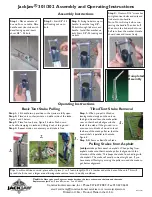
3
WARNING
!
Depressurize valve before servicing.
Before servicing, be certain the shutoff valves are closed. Then
use the following procedure to remove the check assemblies.
1. Slowly open all ball valves to relieve air and water pressure.
Loosen the bolts on the groove coupler and remove the groove
coupling and cover plate from the valve body. (See Figure 1.)
2. Remove check assembly #1 by hand, turning the screws counter-
clockwise to release the check and remove it through the top access
port. Do not use the check arm as a handle to unscrew the unit. If
the check cannot be loosened by hand, insert a long screwdriver
between the valve body and the check. (See Figure 2). Gently apply
pressure against the check until it is loosened. Finish unscrewing by
hand. (See Figure 3.) Unscrew check #2 by turning counterclockwise,
placing a long screwdriver across the lugs and applying pressure to
loosen the check. (See Figure 4.) Fin ish un screw ing by hand.
3. (For 6" only) To clean check #1, locate the check arm opening
stud on the outlet flange of the valve assembly. Slide the check
arm over the stud with the check threads facing downward. (See
Figure 5A.) Tighten the 1/4" nut on the stud to secure the cam bar.
Slowly pull the assembly outward to open the check, allowing
exposure of the seat clapper area for cleaning.
To clean check #2, lift the cam arm and hold it in the open
position. (See Figure 4.) Raise the clapper so that the end of the
check arm rests between the roller and the clapper. (See Figure
5B.) Thoroughly clean the seat area and clapper sealing surfaces
of both checks. Inspect seats, clapper sealing surfaces, check
arms, and O-rings for damage, nicks, and debris. If not damaged,
gently close the clapper. If damaged, install a new check assembly
or O-ring, or both.
4. Before reinstalling the checks, thoroughly clean the O-ring groove
and lubricate the O-ring with an FDA Approved lubricant. Insert
and thread check #2 first and then check #1. Check #2 should
be tightened by inserting a long screwdriver between the lugs to
tighten firmly. (See Figure 2.) Do not overtighten. Tighten check #1
firmly by hand only. Replace the cover plate, clean groove coupler
gasket, and groove. Replace the groove coupler. Repressurize and
bleed air from all the test cocks.
#1 Cam
Check
#2 Cam
Check
Screwdriver
A
B
C
#1 Cam Check
2
1
/
2
" – 6" RP (Short Cam)
O-ring Seal
& Groove
Seat
Clapper
Roller
Spring
Cam Arm
#2 Cam Check DC & RP
O-ring Seal
& Groove Lug
Seat
O-ring Seal & Groove
Clapper
6" Only
Roller
Cam Arm
Spring
Cam Bar Open Pin
Valve Outlet Flange
Threaded Stud on Flange
6" 1st Check DC
6" 2nd Check
DC & RP
Cleaning
Position
Flow
1
2
3
4
5
6
7
8
9
11
10
12
ITEM
DESCRIPTION
ITEM
DESCRIPTION
1
#1 Cam-Check
7
Groove Coupler
2
#2 Cam-Check
8
Groove Coupler Gasket
3
#1 Cam-Check O-ring
9
Relief Valve (complete assembly)
4
#2 Cam-Check O-ring
10
Relief Valve Hose
5
Cover Plate
11
Relief Valve Body O-ring
6
Ball Valve
12
Washer, Shutoff
Servicing the First and Second Checks
Figure 1
Figure 2
Figure 3
Figure 4
Figure 5A
Figure 5B


























